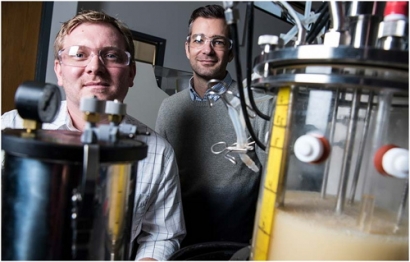
The research was recently published in Scientific Reports in a manuscript titled, “Methane utilization in Methylomicrobium alcaliphilum 20ZR: a systems approach.” NREL researchers and co-authors Calvin Henard and Michael Guarnieri are members of a team looking to discover how M. alcaliphilum 20ZR, a methane-eating organism known as a methanotroph, operates. It was one of the first research efforts of its kind.
“Very little is known about methanotrophic metabolism in general,” Henard said. “These are the first metabolic models generated for this particular organism, which is one of the most promising biocatalysts that can be used to make products from natural gas- and biogas-derived methane.”
Once the metabolism is defined, it can be manipulated and optimized for targeted production of fuel and chemical intermediates.
One of the processes looked at by the team resulted in the production of precursors to nylon – a valuable consumer product whose production is traditionally very environmentally unfriendly. Ideally, they wanted to know if the organism could be engineered to be more effective and efficient.
Henard and Guarnieri used computational and biochemical analyses to study the metabolism of M. alcaliphilum 20ZR that will inform a genetic engineering strategy for the microbe. In modeling how the methane gets funneled through the methanotroph, they uncovered new knowledge.
They observed routes of carbon flow that had not been previously considered, and likely served to promote balance between anabolic reactions and redox demands (changes in the oxidation states of the atoms) in the methanotroph.
While the work focused on modeling, the next step is taking the research to the lab, both to confirm the way methane was used by the methanotroph and to guide engineering efforts to produce a more efficient biocatalyst.
“This opens the door for an array of biogas-derived products,” Guarnieri said. “The nylon precursors are a proof of concept; we’re also targeting production of hydrocarbon fuels, higher alcohols, and additional biopolymers and bio-based materials as potential end products.”
And, because methane is the sole carbon and energy source for the M. alcaliphilum 20ZR, it has greenhouse gas utilization potential for the natural gas and waste management industries.
Other co-authors on the paper published by Scientific Reports include lead and corresponding authors, Ilya Akberdin and Marina Kalyuzhnaya from San Diego State University; Merlin Thompson and Richard Hamilton from San Diego State University; and Nalini Desai and Danny Alexander from Metabolon, Inc.
Funding for the research came from the U.S. Department of Energy Bioenergy Technologies Office under a competitively awarded funding opportunity targeting Biological and Chemical Upgrading for Advanced Biofuels and Products.
Photo: NREL researchers Calvin Henard and Michael Guarnieri are members of a team that set out to discover how a methane-eating organism known as a methanotroph operates. (Photo by Dennis Schroeder/NREL)

